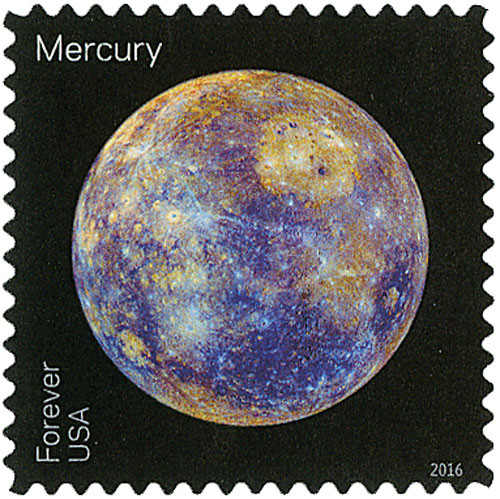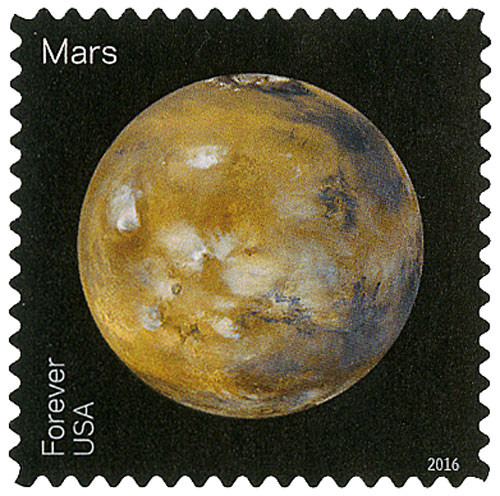
# 5074 - 2016 First-Class Forever Stamp - Views of Our Planets: Saturn
US #5074
2016 Saturn – Views of Our Planets
- Pictures Saturn, the sixth planet from the Sun
- One of 8 stamps issued alongside the 2016 Pluto Explored stamps to commemorate space exploration in our Solar System and New Horizon spacecraft’s flyby of Pluton in 2015
Stamp Category: Commemorative
Set: Views of Our Planets
Value: 47¢ First Class Mail Rate (Forever)
First Day of Issue: May 31, 2016
First Day City: New York, New York
Quantity Issued: 40,000,000
Printed by: Ashton Potter (USA) Ltd.
Printing Method: Offset
Format: Panes of 16
Tagging: Nonphosphored type III, spot tag
Why the stamp was issued: To showcase Saturn, the sixth planet from the Sun, and the NASA efforts that have allowed us to see this planet up-close. To honor NASA’s space exploration efforts within our Solar System that have given us up-close images of every plant and – as of 2015 – dwarf planet Pluto.
About the stamp designs: Pictures an image of Saturn from NASA and the Hubble Heritage Team.
First Day City: The First Day of Issue Ceremony was held at the Javits Center in New York City during the World Stamp Show 2016.
About the Views of Our Planets set: Eight stamps issued to honor NASA’s space exploration efforts within our Solar System that have given us up-close images of every planet and – as of 2015 – dwarf planet Pluto. Each stamp pictures one planet in our Solar System. According to the USPS, “Some show the planet’s ‘true’ color – what we might see with our own eyes if traveling through space. Others use colors to represent and visualize certain features of a planet based on imaging data. Still others use the near-infrared spectrum to show things that cannot be seen by the human eye in visible light.”
History the stamp represents: Saturn was the most distant planet seen by ancient Romans. It was the farthest away from the Sun, so it appeared to move slowest across the sky. For this reason they named it after their god of time.
Similar to Jupiter, Saturn is a “gas giant,” composed of mostly hydrogen and helium. Strong winds of over 1,000 miles per hour join with heat rising from the planet’s interior to form the yellow and gold bands in Saturn’s atmosphere. At the center of the planet is thought to be a molten core made of many materials that solidified under intense pressure and heat.
Galileo Galilei was the first to view Saturn through a telescope in 1610. He noted objects on either side of the planet that later astronomers discovered to be Saturn’s famous rings. In the 1980s, the Voyager missions revealed that these rings were made of water ice and rock chunks. These pieces can be as small as a grain of sand or as big as a house. Scientists believe the rings were formed by Saturn’s powerful gravity tearing apart neighboring moons and other space objects. Through the rings extend thousands of miles away from the planet, they are generally only about 30 feet tall.
Of Saturn’s more than 60 moons, scientists are most interested in Enceladus. It shows signs of salt water, which could possibly support microbial life. And NASA hopes to explore its habitability in the near future.
US #5074
2016 Saturn – Views of Our Planets
- Pictures Saturn, the sixth planet from the Sun
- One of 8 stamps issued alongside the 2016 Pluto Explored stamps to commemorate space exploration in our Solar System and New Horizon spacecraft’s flyby of Pluton in 2015
Stamp Category: Commemorative
Set: Views of Our Planets
Value: 47¢ First Class Mail Rate (Forever)
First Day of Issue: May 31, 2016
First Day City: New York, New York
Quantity Issued: 40,000,000
Printed by: Ashton Potter (USA) Ltd.
Printing Method: Offset
Format: Panes of 16
Tagging: Nonphosphored type III, spot tag
Why the stamp was issued: To showcase Saturn, the sixth planet from the Sun, and the NASA efforts that have allowed us to see this planet up-close. To honor NASA’s space exploration efforts within our Solar System that have given us up-close images of every plant and – as of 2015 – dwarf planet Pluto.
About the stamp designs: Pictures an image of Saturn from NASA and the Hubble Heritage Team.
First Day City: The First Day of Issue Ceremony was held at the Javits Center in New York City during the World Stamp Show 2016.
About the Views of Our Planets set: Eight stamps issued to honor NASA’s space exploration efforts within our Solar System that have given us up-close images of every planet and – as of 2015 – dwarf planet Pluto. Each stamp pictures one planet in our Solar System. According to the USPS, “Some show the planet’s ‘true’ color – what we might see with our own eyes if traveling through space. Others use colors to represent and visualize certain features of a planet based on imaging data. Still others use the near-infrared spectrum to show things that cannot be seen by the human eye in visible light.”
History the stamp represents: Saturn was the most distant planet seen by ancient Romans. It was the farthest away from the Sun, so it appeared to move slowest across the sky. For this reason they named it after their god of time.
Similar to Jupiter, Saturn is a “gas giant,” composed of mostly hydrogen and helium. Strong winds of over 1,000 miles per hour join with heat rising from the planet’s interior to form the yellow and gold bands in Saturn’s atmosphere. At the center of the planet is thought to be a molten core made of many materials that solidified under intense pressure and heat.
Galileo Galilei was the first to view Saturn through a telescope in 1610. He noted objects on either side of the planet that later astronomers discovered to be Saturn’s famous rings. In the 1980s, the Voyager missions revealed that these rings were made of water ice and rock chunks. These pieces can be as small as a grain of sand or as big as a house. Scientists believe the rings were formed by Saturn’s powerful gravity tearing apart neighboring moons and other space objects. Through the rings extend thousands of miles away from the planet, they are generally only about 30 feet tall.
Of Saturn’s more than 60 moons, scientists are most interested in Enceladus. It shows signs of salt water, which could possibly support microbial life. And NASA hopes to explore its habitability in the near future.












